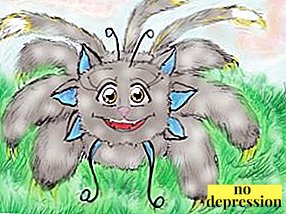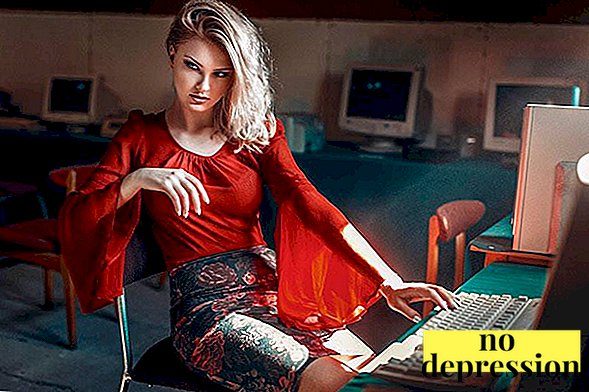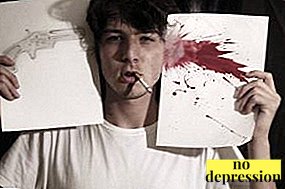Have you ever met the name "Method non-existent animal"?
Its already quite a long time used in psychological diagnosis, and it showed its effectiveness and information.
Who is the author?

To draw a fantastic animal, to name it and describe it - what kind of psychology is this (see example)?
The author of the test is Maya Zakharovna Dukarevich, a well-known practicing psychologist, a projective test specialist.
Developments were carried out in the 70s of the last century, but the test was published only in the 90s.
Technique explores identity based on an image of an animal that is not present in real life, in cinema or other areas of art.
It is the drawing of such an image that makes it possible to evaluate the personality of the subject, his emotional sphere.
Among psychologists test is popular as the most simple and informative. Use it to study children and adults.
It can be interesting for children as a proposal to create something unusual.
For whom and where is it used?
The test is in demand when working with students, apply it recommended for children after 5-6 years, because until this age the child is not fully aware of himself and his attitude to the world.

However, modern psychologists can use it to diagnose adults.
Besides the fact that the animal is required to depict, it is also necessary and to name.
School psychologists use the technique in examining the personality of children, the need to find out their mental state, the presence of deviations.
For adults the test can be claimed. when applying for a job. He is not the only, but only auxiliary.
What is the purpose?
What does she show? The main purpose of the method "non-existent animal" - personality diagnosis. In the process of drawing, the child puts on paper his inner world, his image of himself.
Based on the image, the psychologist can tell about the mood, self-esteem, existing internal problems, complexes, attitude to the world and other people.
Considered one of effective projective techniques.
Features of the application for children

To perform the need clean paper, simple pencil, eraser.
Instructions are given: to draw an animal that does not exist, which no one has yet invented, even in fairy tales.
If a child doubts and says that he does not know how, he should cheer him up and say that no matter how the drawing will turn out, the main thing to draw as he wants. It may be advisable to start drawing, how it turns out, and then finish the details.
When the drawing is fully prepared, the psychologist discusses with his child his peculiarities: what kind of animal, what it does, what is its name, what sex it is, whether it has a family, what emotions it experiences.
Such details allow, in addition to the interpretation of the image itself, to better understand the inner world of the child, his attitude towards himself.
Description
The main goal: draw an animal that does not exist.

There is a modification of the test: "Evil animal", which allows to reveal the hidden depression and aggressive state.
The procedure for carrying out, examination and interpretation is not generally accepted standards, as this projective testand each psychologist can contribute something of his own.
Most often it is proposed to use a simple pencil, but in some cases are given and coloredin order to better assess the subject's emotions, his depression (if he prefers to use mostly black and gray shades).
During the examination, this technique is not unique, but only complements other ways of assessing personal characteristics.
How are the results processed?
Evaluated the location of the animal on the sheet, in which direction the muzzle is directed, the tail, are there any protruding parts, how aggressive is the design.
Psychologist watching pressure lines, the presence of hatching, the frequency of erasure, the presence or absence of certain parts of the body, their location relative to other elements.
Location on the sheet

Normal picture should be located about the middle line.
If he is significantly higher, this is interpreted as a high level of self-esteem, which is investigated dissatisfied with his position, lacks recognition.
If drawing is very low, it tells about insecurity, low self-esteem, depressed state, avoiding communication with society.
Main parts
- Large eyes can mean having inner fears.
- Eyelashes - the desire to be admired by those around you.
- Mouth. If it contains teeth, it means verbal aggression. Ajar with traced language - sociability, speech activity. If there is no language, readiness to be afraid.
- Head big - erudition, the need for knowledge. If it does not exist, it can indicate the presence of mental disorders. Two or more - the duality of desire.
- Figure. If there are many components, it indicates a high level of energy.
Little elements - asthenia, low energy level. A lot of protruding corners - outward aggression.
If the figure, on the contrary, is round and closed, it means stealth, a desire to shut out.
- Tail - how the subject relates to his own actions. If it is directed upwards - a positive attitude, downwards - a negative one. Turn to the right - how the subject relates to his behavior, to the left - to his thoughts. It is important to take into account additional details - protrusions, spikes, split tail, decoration.
- Ears. Their presence means that it is important to the subject what is being said about him. The absence of ears - for him the opinion of others does not matter, he does not want to hear them.
- Horns - protection. If there are also claws - aggressive defense, attack.
- Hairstyle, mane - underscore belonging to your floor.
- Wings - fantasy, dreaminess. Opened wings can mean the desire to "fly up" above, to achieve success.
- Legs - this is a support, how firmly and confidently the subject feels. If there are none, passivity. Too much - the need for support, support, uncertain state, unsteadiness.
It is worth seeing how the legs connect with the body - it is the control over their reasoning - how careless they are or if they are drawn neatly.

Decorations and additional items
Analysis:
- scales - the need for protection, the shell indicates the need for a high level of protection, the desire to hide, to hide;
- pattern on the body - a manifestation of demonstrativeness;
- traced internal organs - anxiety, mental illness, a sharpness in one's health - hypochondria;
- genitals - the subject attaches great importance to sex life or he is strongly interested in this area;
- wounds - neurotic manifestations;
- mechanical elements - difficulties in establishing social contacts;
- the whole body is covered hair - the importance of the sexual sphere;
- weapon - aggressiveness.

Total energy
The experimenter studies the number of parts, their location, the pressure lines.
If there are few details, the pressure is barely noticeable, but exhaustion is observed, asthenia, energy is barely enough for life.
Many different details - increased energy level, activity. If a lines are very fatIt speaks of anxiety. Also estimated pressure uniformity.
Type of animal

He might be:
- neutral;
- threatening;
- fearful;
- weak;
- threatened person.
The assessment is made on the basis of a set of signs and the presence of various elements - round, sharp, closed, as well as the location on the sheet.
Creation
Studied by the number of elements, their unusualness, Is the animal really fictional or is it based on a character from a film, a book or other sources?
Title
It also evaluates the name the subject gave to the animal:
- contains real names - motley hare, jumping hippo - speaks of rational thinking;
- using scientific meanings talks about the desire to show their erudition;
- titles without meaning - frivolous, superficial attitude to life;
- duplicate elements - quack-quack, which can express infantilism;
- ironic - easy, ironic attitude to life;
- very long names - a departure from reality.
What do you do?
Action and its decoding:
- breaks down something - aggressive behavior;
- looking for food - the presence of life difficulties;
- is sleeping - asthenia, fatigue, depression;
- having fun - projection of the subject's wishes;
- doing something unusual - going beyond the standards or the desire to break the established order.
Fictional creature for the interview

What non-existent animal is better to draw for a psychologist at the interview, to not recruit?
In some cases, the projective technique is used when applying for a job.
The candidates have a question - how to portray an animal that does not exist to take the test?
- Pay attention to the location of the animal - the best option - in the center of the sheet. If the work involves high activity, then the picture should show the presence of a sufficient level of energy.
- Because mouth open with teeth speaks about the presence of verbal aggression, it is necessary to portray it more gently. If the work involves communication, then a fully closed mouth will not work.
- Lines are performed with even pressure.
- Paws should stand firmly on the ground, clearly connected with the main figure.
- Big eyes mean the presence of fears, so draw them in proportion to the head.
- If you want to show high self-esteem level, the tail should be pointing upwards.
When applying for positions where creativity is required, you will have to show creativity and make the animal interesting by making a variety of elements, but you should also avoid oversupply so that there is no suspicion of mental disorder.
The technique presented is - very interesting in terms of studying the personality of children and adults, so many psychologists apply it in practice.
Take a picture test - "Unknown animal":



